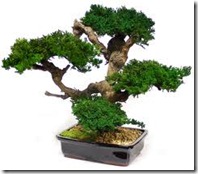 The art of bonsai, or Bon Sai (tray-growing) is a deeply enriching hobby that can help relieve stress and be a beautiful addition to any home or office. First introduced in China around a thousand years ago, known as pun-sai, it migrated to Japan in the Kamakura period, between 1185 and 1333, by way of Zen Buddhism. Once there, the art exploded with new ideas and concepts. The Japanese created countless styles and techniques, many of which are still used today. Wire andbamboo sticks are often used to help shape young plants. Bonsai finally made its way to the rest of the world in the mid 1900s after Japan opened its doors to share its time honored traditions. Which technique the artist uses depends greatly on personal taste, style and time demands.
The art of bonsai, or Bon Sai (tray-growing) is a deeply enriching hobby that can help relieve stress and be a beautiful addition to any home or office. First introduced in China around a thousand years ago, known as pun-sai, it migrated to Japan in the Kamakura period, between 1185 and 1333, by way of Zen Buddhism. Once there, the art exploded with new ideas and concepts. The Japanese created countless styles and techniques, many of which are still used today. Wire andbamboo sticks are often used to help shape young plants. Bonsai finally made its way to the rest of the world in the mid 1900s after Japan opened its doors to share its time honored traditions. Which technique the artist uses depends greatly on personal taste, style and time demands.
Though growing a bonsai tree from a seed can be a rewarding journey, it can take years to mature into a suitable plant to begin styling. So for the beginning bonsai artist it is suggested you buy a sapling from a nursery or even simply find one in the back yard or surrounding area. There are many plants that can be used for a bonsai tree, from rosemary to a variety of maples. Below is outlined how to plant a Bonsai tree and begin the bonsai experience.
Step 1: Plant Selection and Pruning
Although almost any plant can become a graceful bonsai tree, there are some that can make the best trees for beginners. A few of these are:
Japanese Red Maple – They are valued for their compact size and wonderful autumn colors, ranging from a rich gold to a deep blood red. They have delicate ferny foliage.
Trident Maple – A traditional tree for bonsai. It has rich colors in the fall. With a thick trunk, it is known for having a bushy-top.
Chinese Elm – Native to China, this tree adapts to its climate. Depending on how cold it gets, it may or may not drop its leaves in the fall.
Serissa – "The Tree of a Thousand Stars". This tree has tiny leaves and buds small white flowers. It also has a pungent smell when plucked or pruned.
Now that the plant for potting is chosen, pruning is in order. Begin by trimming a portion of the top half. How much is trimmed dictates how large the tree will be. It is a recommended rule that one half to two-thirds of the plant be pruned. The roots of the plant are next and the same rule applies here as well. Leaving most of the thin white roots, or feeder roots, and some of the older thicker roots, if there are any.
Step 2: Potting and Soil
The soil chosen should be a standard well-drained soil mix. The type of soil also depends highly on the type of plant selected. Research is advised to find out the best blend of soil for the bonsai tree to ensure a healthy growth, but a good start if unsure of soil type would be 30% grit and 70% humus for deciduous trees, plants that loose their leaves in autumn. For evergreens or needled plants use 70% grit and 30% humus. Just remember there are times when a different mix may profit the plant.
The pot should be two-thirds to three-fourths wide as the plant’s width and one-half as deep as the plant is high. The style of pot like the plant itself depends greatly on the grower. Many bonsai fans use earth tones to enhance the natural beauty of the plant.
Begin by placing a small amount of soil in the bottom of the pot. Next, place your plant on top and fill in around it with the soil. Pat gently to secure the small tree. A stick or finger can be used to carefully pat the soil in around the roots. Trim any roots that are hanging over the edge of the pot.
Step 3: Watering
Most planting soils are dried out and because the tree is kept in a small space, watering is important. In order to train the soil to hold water, the potted tree should be placed in a tub with a handful of water. Give it only enough time for the soil to absorb the water. Never leave the tree in water for more than a few hours. For the first few weeks after planting it is important that the plant be watered twice a day. The soil should stay moist and not be allowed to dry out.
However, beware of over watering your plant, as the roots may begin to rot away. If the soil is moist through out then it is unlikely that it is time for the next watering. Some like to place moss in the pot along with the tree in an effort to make it look like a tree on a grassy hillside. While lovely, if the moss growth is too much, it can be harmful. The moss could act as a shield on top of the soil, keeping the water from reaching the roots below

Deprecated: strpos(): Passing null to parameter #1 ($haystack) of type string is deprecated in /home/agriviek8Qv/agriviet.net/public_html/wp-includes/comment-template.php on line 2522